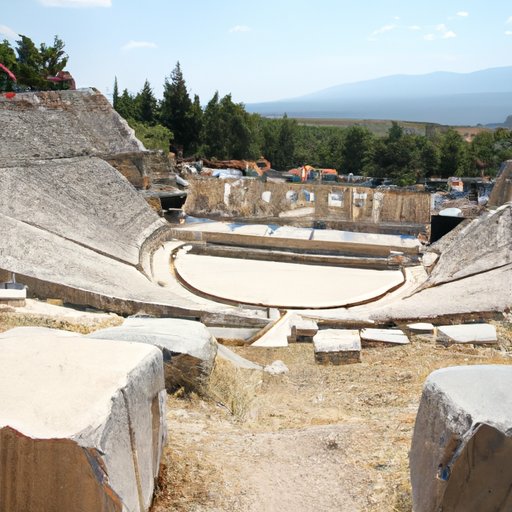Introduction
Greek theater is a form of theater that originated in Ancient Greece. It is considered to be one of the earliest forms of theater, and has had a lasting impact on modern theater. This article will explore the history of Greek theater, its architecture and design, the role of the chorus, themes and characters, and its impact on modern theater.

Exploring the Architecture and Design of a Greek Theater
A Greek theater was typically built on a hillside with a large, curved auditorium. This auditorium was divided into three sections: the orchestra, the skene, and the theatron. The orchestra was the circular area where the actors performed; the skene was the backstage area where props and sets were stored; and the theatron was the seating area for the audience. Greek theaters also featured a proscenium arch, which was used to separate the stage from the audience.
The acoustics of Greek theaters were also incredibly important. The curved shape of the auditorium allowed sound to travel from the orchestra to the theatron with ease, allowing the performers to be heard clearly by the audience. This design was so effective that many modern theaters still use similar designs today.

The Roles and Significance of the Chorus in Ancient Greek Theater
The chorus was an integral part of ancient Greek theater. The chorus was composed of a group of people who would sing and dance throughout the performance, often providing commentary on the action and exposition. The chorus was also used to move the story forward, as they would often provide exposition and information about the characters and their motivations.
The chorus was also seen as a representation of the people, and their collective opinion was seen as having a powerful influence on the outcome of the play. As such, the chorus was seen as a vital part of Greek theater, and its role was often used to comment on the social and political issues of the time.
An Analysis of the Themes and Characters of Greek Theater
Greek theater featured a variety of themes, including fate, love, power, and justice. These themes were often explored through the archetypal characters that appeared in the plays, such as the hero, the villain, the wise old man, and the fool. Many of these characters and themes are still used in modern theater today.
Greek plays also often featured gods, goddesses, and other mythical creatures. These figures were used to explore the power dynamics between humans and the gods, as well as to illustrate the consequences of challenging the gods. This theme of challenging authority is still prevalent in modern theater.
Examining the Impact of Greek Theater on Modern Theater
Greek theater has had a lasting impact on modern theater. Many of the elements of Greek theater, such as the use of chorus, themes, and characters, can be seen in modern theater productions. In addition, the design of the theater itself has had a lasting influence on modern theater, as the curved auditorium of the Greek theater is still used in many modern theaters today.
In addition to its influence on modern theater, Greek theater has also had an impact on literature, film, and television. Many of the themes, characters, and plot devices used in Greek plays are still used in modern media, illustrating the lasting influence of Greek theater.

Exploring the Development of Greek Theater Over Time
Greek theater evolved over time, with different stages of development. The first stage was the Pre-Classical period, which lasted from 600 BC to 480 BC. During this period, plays were performed in honor of Dionysus, the god of wine, and the focus was mainly on religious rituals. The second stage was the Classical period, which lasted from 480 BC to 323 BC. This period saw the introduction of new genres of theater, such as tragedy and comedy, and the rise of famous playwrights such as Aeschylus and Sophocles.
The third stage was the Post-Classical period, which lasted from 323 BC to 146 BC. During this period, theater became more popular, and new genres such as satyr plays and mime emerged. The fourth and final stage was the Hellenistic period, which lasted from 146 BC to 31 BC. During this period, theater became even more popular, and many new plays were written and performed.
Conclusion
Greek theater is an important part of theater history. Its influence can be seen in modern theater, literature, film, and television. This article has explored the history of Greek theater, its architecture and design, the role of the chorus, themes and characters, and its impact on modern theater. Greek theater has had a lasting influence on modern theater, and its importance should not be overlooked.
(Note: Is this article not meeting your expectations? Do you have knowledge or insights to share? Unlock new opportunities and expand your reach by joining our authors team. Click Registration to join us and share your expertise with our readers.)
